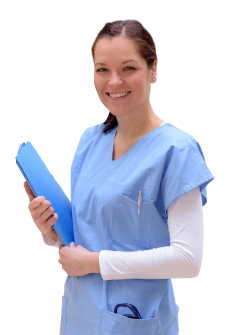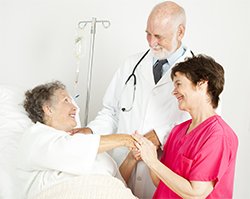You are aware of the many benefits of repositioning your patients. Effective patient positioning has been a focal point throughout the history of nursing. Among the many benefits of proper positioning, preservation of skin integrity is an important factor as the costs of treating a pressure ulcer are estimated to range from $40,000 to $70,000 for newly developed ulcers.(1) The Agency for Healthcare Research and Quality (AHRQ) defines a pressure ulcer as a lesion caused by unrelieved pressure resulting in damage to underlying tissue.(2) Pressure ulcers are not unique to modern times,as they have been discovered on the remains of Egyptian mummies.(3)

Abundant literature spanning various practice settings and specialties reveals it is much more cost-effective to focus on prevention rather than treatment of pressure ulcers. Studies demonstrate that 3% to 10% of the population in both hospital and community health care settings acquire some degree of pressure damage.(4) The resulting cost, patient discomfort, and increased hospital length of stay (LOS) are significant. The cost of pressure ulcer treatment exceeds more than $1 billion annually in the United States. This is estimated to be two and one-half times the cost of prevention.(5)
Most of the previous research concentrates on long-term care settings, intensive care units (ICU), and rehabilitation units; with little attention given to the acute care setting. These studies led to the development of protocols, policies, procedures, and educational programs aimed at decreasing nosocomial pressure ulcers. Improvements have been made in the identification and production of effective pressure-reducing surfaces; however, the prevalence and incidence of pressure ulcers are not diminishing.
Researchers have found that pressure ulcers are a significant, independent predictor of both hospital costs and LOS.(6)
Each year, approximately 1.6 billion patients develop hospital-acquired pressure ulcers at a cost of $2.2 to $3.6 billion. Of these ulcers, 23% occur on surgical patients undergoing procedures lasting more than three hours and represent an annual direct cost of $750 million to $1.5 billion.(7)
 Another study found that patients who develop iatrogenic pressure ulcers have a mean hospital cost $1,877 greater and a LOS four days longer than patients who do not develop pressure ulcers. For patients who develop a stage II or greater pressure ulcer, costs are $15,229 greater and LOS is extended eight days longer than patients without pressure ulcers. Another group of researchers found that patients who develop pressure ulcers have an average LOS seven days longer than patients who do not develop ulcers.(8)
Another study found that patients who develop iatrogenic pressure ulcers have a mean hospital cost $1,877 greater and a LOS four days longer than patients who do not develop pressure ulcers. For patients who develop a stage II or greater pressure ulcer, costs are $15,229 greater and LOS is extended eight days longer than patients without pressure ulcers. Another group of researchers found that patients who develop pressure ulcers have an average LOS seven days longer than patients who do not develop ulcers.(8)
In addition to increased dollars, other costs are associated with pressure ulcer development. Increased pain, infectious complications, additional use of hospital resources, failure to heal, and increased mortality may occur in patients with pressure ulcers.
One study found that death is more likely to occur in these patients.(9) Findings show that 67% of pressure ulcer patients die during hospitalization compared to 15% of pressure ulcer negative patients and that increased mortality extends through the first year postdischarge.(10) In fact, 59.5% of patients who develop pressure ulcers die within one year of discharge compared to 38.2% of patients without pressure ulcers.
 Another researcher discovered that the inpatient death rate for pressure ulcer positive patients ranges from 23% to 37%.(11) When adjusted for life expectancy, functional status, and other complications, however, pressure ulcer formation is not an independent predictor of death.
Another researcher discovered that the inpatient death rate for pressure ulcer positive patients ranges from 23% to 37%.(11) When adjusted for life expectancy, functional status, and other complications, however, pressure ulcer formation is not an independent predictor of death.
Effective patient repositioning also benefits the pulmonary system. It aids in the prevention and treatment of pulmonary complications. Nosocomial infections complicate the recovery of hospitalized patients and exact a heavy toll in terms of mortality and healthcare dollars. In 1991, for example, they were directly linked to more than 80,000 deaths at a price tag that approached $10 billion by some estimates.(12-13)
About 20% of all nosocomial infections occur in critically ill patients and usually affect the respiratory system.(14-15) The prevalence of hospital-acquired pneumonia (HAP)—defined as a pneumonia occurring more than 48 hours after admission—is unknown, but current estimates suggest a rate as high as 10 cases per 1,000 admissions with a 20-fold increase for patients on mechanical ventilation. HAP has a mortality rate of 30%, the highest of all nosocomial infections, and prolongs hospital stays by as much as seven to nine days per patient.(16)
Some specialty beds and surfaces deliver what is known as Kinetic Therapy. Kinetic Therapy is defined by the CDC as 40-degree rotation or greater to each side (an 80 degree arc) using a specialty bed.(17) Although the importance of movement in a patient’s recovery has been known for years, recent scientific evidence has also shown a pulmonary benefit associated with rotational therapy greater than 40°.(18-23)
 In 1998, Elsevier Science Ltd. published a study entitled: Is early kinetic positioning beneficial for pulmonary function in multiple trauma patients? “Body positioning (kinetic therapy) is known to improve oxygenation in patients with impaired pulmonary function and ARDS. We have used body positioning prophylactically in trauma patients whose injury and pattern predispose to ARDS. The retrospective study reports the effects of early prophylactic axial rotation on pulmonary function and the incidence of ARDS. Both groups were comparable in age, injury severity and the degree of thoracic injury. Systemic oxygenation was significantly better and the incidence of ARDS significantly lower in group P (group P: 34.3 percent, group T: 74.1 percent, P<0.05). There was a tendency towards a lower incidence of pneumonia and a better survival in group P, which did not reach statistical significance. The duration of kinetic therapy and of ventilation was comparable in both groups. In this retrospective evaluation early prophylactic kinetic therapy was associated with a significantly lower incidence of ARDS compared with that instigated later.” (24)
In 1998, Elsevier Science Ltd. published a study entitled: Is early kinetic positioning beneficial for pulmonary function in multiple trauma patients? “Body positioning (kinetic therapy) is known to improve oxygenation in patients with impaired pulmonary function and ARDS. We have used body positioning prophylactically in trauma patients whose injury and pattern predispose to ARDS. The retrospective study reports the effects of early prophylactic axial rotation on pulmonary function and the incidence of ARDS. Both groups were comparable in age, injury severity and the degree of thoracic injury. Systemic oxygenation was significantly better and the incidence of ARDS significantly lower in group P (group P: 34.3 percent, group T: 74.1 percent, P<0.05). There was a tendency towards a lower incidence of pneumonia and a better survival in group P, which did not reach statistical significance. The duration of kinetic therapy and of ventilation was comparable in both groups. In this retrospective evaluation early prophylactic kinetic therapy was associated with a significantly lower incidence of ARDS compared with that instigated later.” (24)
“Body positioning is an inexpensive non-invasive method, which is known to improve oxygenation. The technique involves alternating prone and supine positioning or continuous axial rotation (kinetic therapy).” (24) Many clinical studies have been conducted to research the clinical benefits of various degrees of rotation. These studies show that degree of rotation plays a critical role in the treatment and prevention of pulmonary complications. In the following clinical studies, while different degrees of rotation were delivered, statistically significant beneficial results for the treatment and prevention of pulmonary complications were seen only when 40 degrees or more of lateral rotation was administered. McLean, B. Use of Progressive Lateral Rotation in Pulmonary Management of Refractory Hypoxemia.
Poster presented at January 1999 SCCM, San Francisco, California. This randomized, prospective study compared the use of 45-degree Kinetic Therapy (90 degree arc) to conventional two hour turning. The study showed a 0% incidence of ARDS in the group receiving 45 degree Kinetic Therapy, while 50% of the group receiving conventional two hour turning developed ARDS.
Choi, SC; Nelson, LD. Kinetic Therapy In Critically Ill Patients: Combined Results Based On Meta-Analysis.
Journal of Critical Care, March 1992. This meta-analysis of 419 patients concluded that when 40 degree or more of Kinetic Therapy is initiated within 24 hours of admission and used for ten days, the results are a 24% reduction in ICU stay, a 35% reduction in hours intubated and a 50% reduction in ICU-acquired pneumonia.
Raoof, Suhail, MD, FCCP; et al. Effect of Combined Kinetic Therapy and Percussion Therapy on the Resolution of Atelectasis in Critically Ill Patients. CHEST, 1999; 115; 1658—1666.
This prospective and randomized study measured the effect of Kinetic Therapy (>40 degree to each side) combined with mechanical percussion in the resolution of established atelectasis of the lungs and hypoxemia in critically ill, hospitalized patients. Partial or complete resolution of atelectasis was seen in 82.3% of the test group, as compared to 14.3% of the control group. Bronchoscopy was performed in 43% of the control group, but in none of the patients in the test group. Also, an improvement in oxygenation index occurred in the test group (Pa02/Fi02) at the end of therapy, while the control group showed a reduction over a similar duration of time.
Traver, GA; et al. Continuous Oscillation: Outcome In Critically Ill Patients. Poster presented at the 1993 ALA/ATS International Conference, San Francisco, CA. This randomized, prospective study compared the use of a continuous oscillation bed to traditional two hour turning. The study demonstrated that when patients were mechanically rotated to 24 degrees on a specialty bed, there was no statistically significant difference between the continuous oscillation bed group and the standard bed group.
Whiteman, K; et al. Effects of Continuous Lateral Rotation Therapy On Pulmonary Complications In Liver Transplant Patients.
American Journal of Critical Care, March 1995; 4:133—139. This randomized prospective study revealed no significant differences in the length of mechanical ventilation and ICU stay between patients turned to 30 degrees and those patients placed on stationary beds.
Dolovich, M; et al. Effect of Kinetic Therapy On Lung Mucous Transport In Mechanically Ventilated Patients.
Journal of Critical Care, September 1998. This study shows that 30-degree lateral rotation does not appear to stimulate mucous clearance over a four-hour period.
We have outlined and referenced many clinical studies that answer the question, “Why repositioning your patients is so important.” Lateral positioning can prevent the adverse effects of prolonged bed rest, such as formation of decubitus ulcers and atelectasis(25-27), improve oxygenation in patients with unilateral lung disease(30-31), and decrease length of stay in the intensive care unit and occurrence of complications such as fever and atelectasis in patients after cardiac surgery.(31-32)
Laterally repositioning a patient allows the skin to recover from pressure. Changing your patient’s position frequently relieves pressure, which if unrelieved, is the most common cause of pressure ulcers.
